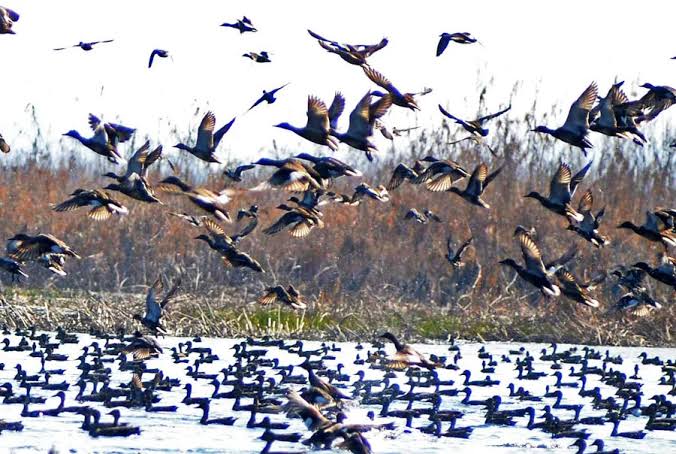Srinagar: Kashmir’s wetlands have turned into a bustling haven for migratory birds this season, witnessing an unprecedented surge with 13.43 lakh birds representing 67 species flocking to the Valley. Over the past six years, the water bird population in these wetlands has shown a major upward trend of up to 65 per cent.
According to the census document accessed by KNO, a total of 1,343,506 birds belonging to 67 species were recorded across 26 wetlands. Hokersar contributed 29.97% of the total bird count, followed by Shallabugh (29.44%) and other wetlands (40.59%). Eurasian Teal (Anas crecca) with 292,039 individuals (22.17% of total bird count) was the most abundant species, followed by Mallard (Anas platyrhynchos) with 226,023 individuals (17.16%) and Northern Shoveler (Spatula clypeata) with 209,715 individuals (15.92%).
The seven bird species—Mallard (Anas platyrhynchos), Eurasian Teal (Anas crecca), Northern Pintail (Anas acuta), Eurasian Coot (Fulica atra), Northern Shoveler (Spatula clypeata), Gadwall (Mareca strepera), and Eurasian Wigeon (Mareca penelope)—constituted 91.08% of the total birds counted during the AWC 2025.
An in-depth assessment and analysis of waterbird count data from the Asian Waterbird Census (AWC) over the period 2019–2025 demonstrates notable trends in population dynamics of major wintering species in the wetlands of Kashmir. Among these, the Eurasian Teal (Anas crecca) consistently recorded the highest abundance, reaching 336,053 individuals in 2022 and 292,039 in 2025, suggesting a stable preference for the region’s shallow, vegetated wetlands.
These trends can be meaningfully correlated with the implementation of wetland management interventions, particularly the construction of bunds and habitat restoration for water retention. Bund creation has been instrumental in maintaining stable water levels during critical wintering months, directly enhancing the foraging and roosting conditions for dabbling ducks such as the Mallard (Anas platyrhynchos), Northern Shoveler (Spatula clypeata), and Gadwall (Mareca strepera), which all showed relatively high and stable counts in recent years. The Northern Shoveler population, for instance, increased dramatically from 53,868 in 2019 to 209,715 in 2025, a change that aligns with improved water retention capacity and reduced human disturbance in managed zones.
Over the span of the last six years, from 2020 to 2025, the water bird population in the wetlands of Kashmir has shown a remarkable upward trend, rising from 813,043 individuals in 2020 to 1,343,506 in 2025, marking a significant 65.28% increase over the period. This increase of over half a million birds demonstrates the success of sustained conservation efforts and wetland management strategies implemented by the Department of Wildlife Protection, Jammu and Kashmir.
One of the most impactful measures contributing to this growth has been the creation of bunds and the installation of regulatory gates in major wetland Ramsar sites such as Hokersar, Hygam, and Shallabugh, which improved water retention capacity and helped maintain stable water levels throughout the migratory and breeding seasons. Desilting efforts, particularly intensified after 2020, rejuvenated open water areas and improved the depth and quality of aquatic habitats, directly correlating with the spike in bird numbers in 2021 and 2022.
Habitat restoration activities, including the removal of invasive weeds and promotion of native aquatic vegetation, contributed to increased habitat heterogeneity, attracting a more diverse array of water birds. Peripheral channels were restored and regularly maintained, reducing habitat fragmentation and supporting both core and buffer zones of the wetland. Solid waste management initiatives significantly reduced pollution and human disturbance, improving the overall health of the ecosystem.
Another key intervention was continuous water quality monitoring, which allowed timely action to address issues such as eutrophication and pH imbalances. Equally important were anti-poaching measures, including intensified patrolling and community compliance programs, which minimised threats during peak migratory influx and protected critical roosting areas.
The upward census trend over the past six years is not merely a reflection of migratory patterns but a direct outcome of holistic, science-based wetland management. (KNO)

